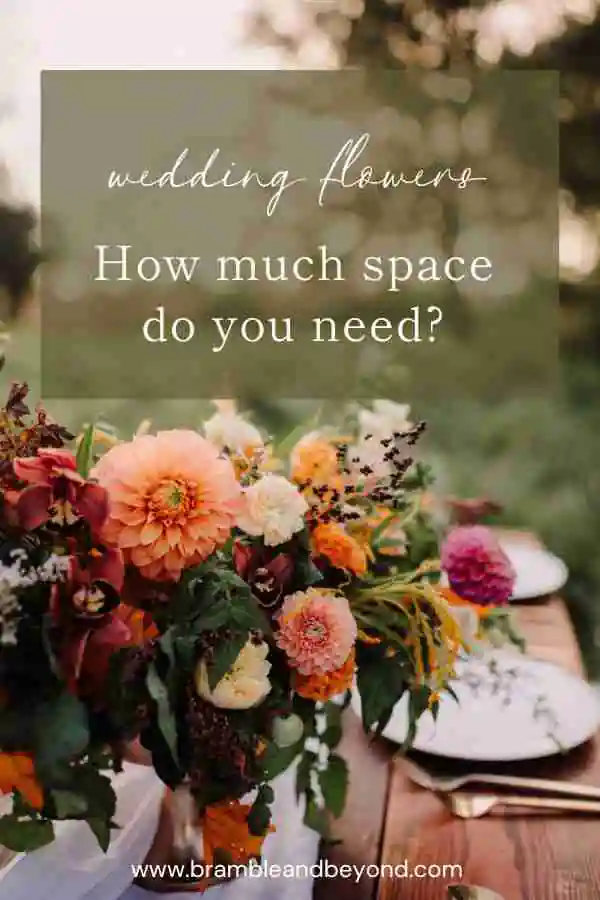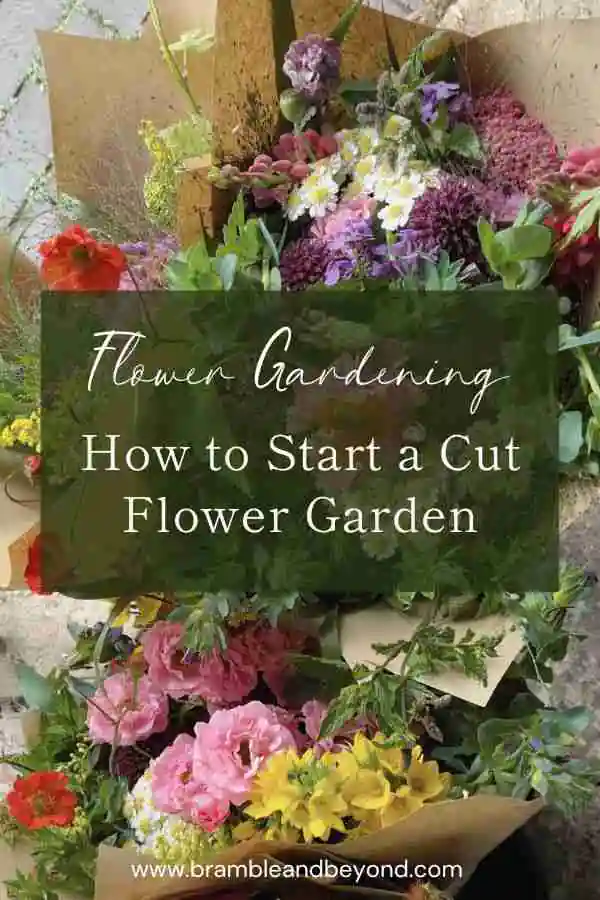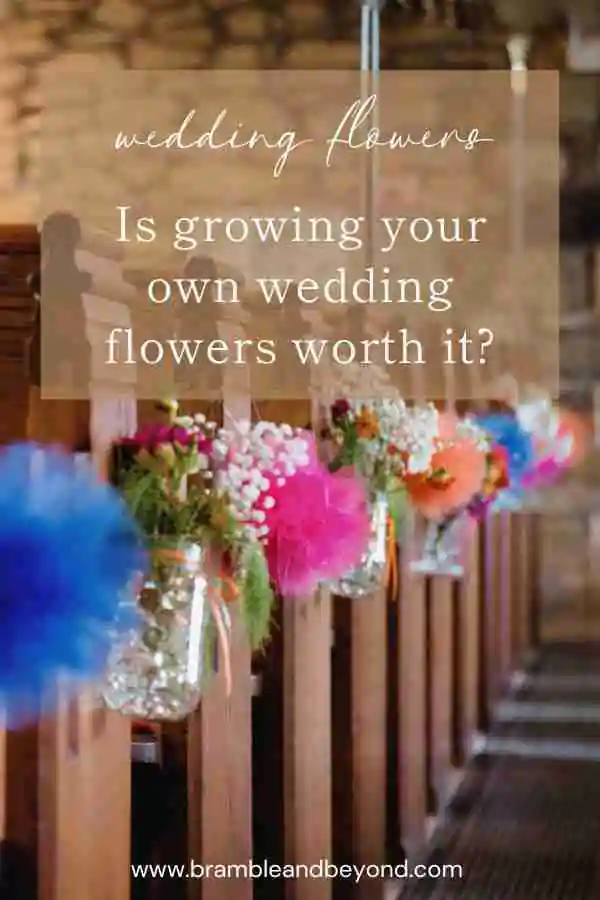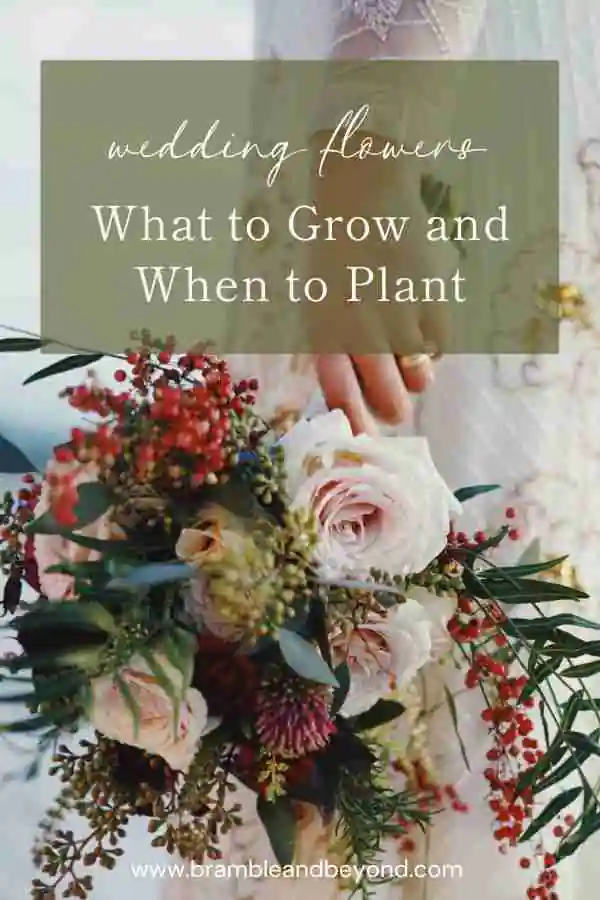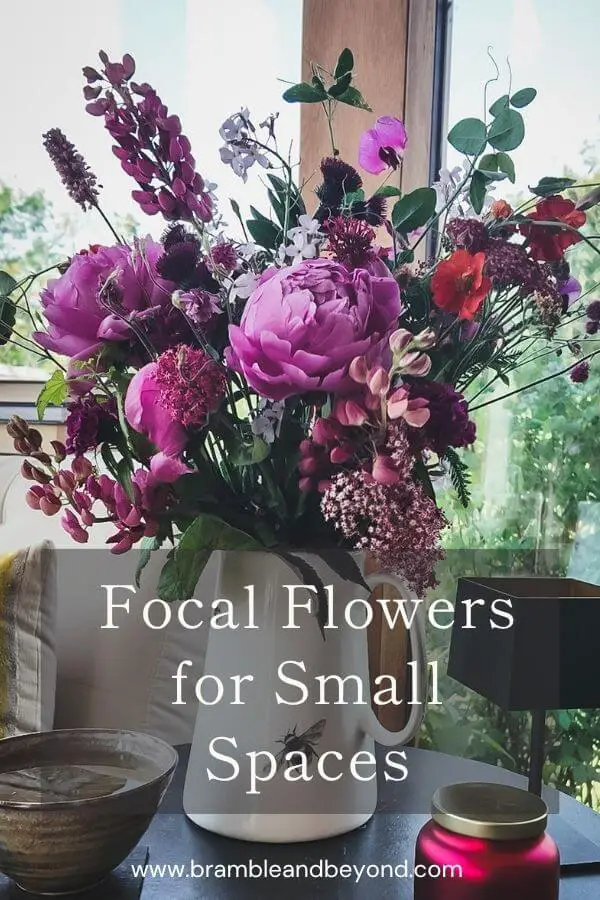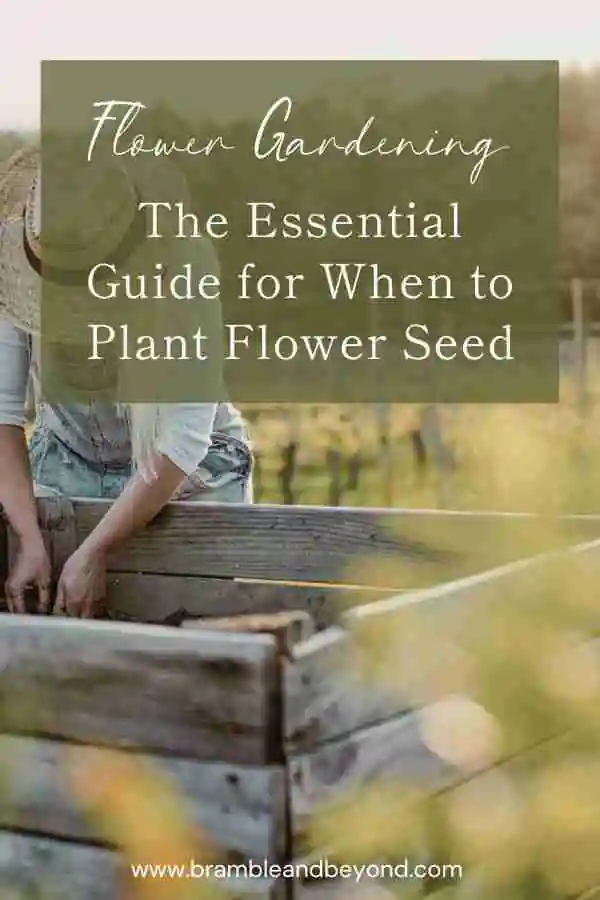Disclosure: This post may contain affiliate links, meaning I get commission if you decide to make a purchase through my links, at no cost to you. Please read my Affiliate Disclosure for more information.
When it comes to planning a wedding, one of the most important things to consider is the flowers. They can add a touch of elegance and beauty to any wedding and are an essential part of the decor. However, if you are trying to control your wedding costs, growing your own flowers might save you some money. But how much space do you need to grow your own wedding flowers?
On average, if you have 100 guests, you need about 20m2 to grow all your wedding flowers. However, this will vary depending on the number of guests, the number of arrangements you want, or if you have access to any existing established perennials, shrubs, or trees.
In this post, I’ll take a look at how much space you need to grow your wedding flowers and how to calculate this.
Why grow your own wedding flowers
Before we dive into how much space you need to grow your own wedding flowers, let’s talk about why you might want to grow your own flowers. There are many benefits to growing your own wedding flowers, including:
Cost savings: Buying flowers from a florist can be expensive, but growing your own can be much more affordable. Here is a post discussing whether you can save money by growing your wedding flowers.
Personalisation: When you grow your flowers, you have complete control over the colours and types of flowers you use, allowing you to personalise your wedding decor to your style.
Sustainability: Growing your flowers is a sustainable choice, as it reduces the environmental impact of shipping flowers from far away and the use of chemicals.
If you want to know more about the factors to consider when planning to grow your wedding flowers, read this post.
How much space do you need to grow your own wedding flowers
The amount of space you need to grow your own wedding flowers will depend on a few factors, including:
- The types of flowers you want to grow: Some flowers require more space than others, so consider the types of flowers you want to use in your wedding decor.
- The size of your wedding: The more flowers you need, the more space you’ll need to grow them.
- Access to existing gardens: If you have access to existing established gardens, either your own or friends or family, this will reduce your need to grow all of the flowers from scratch and, therefore, the space you need.
For a cutting garden, you can take a more laid-back approach if your only goal is to have enough flowers on a week by week basis. This means you’ll need less space as your main aim is to ensure a steady supply of flowers over a longer period of time.
If you are growing your own wedding flowers, then you need all of your flowers ready for one specific day. This means you need the space to grow a lot of flowers all at once.
The table below shows the number of stems you may require for a typical wedding of 100 guests. If you have more or fewer guests, you can scale accordingly. Also, your arrangements may differ in stem numbers depending on the flowers you use. This is just meant to be a guide.
| Arrangement | No. of Stems | No. of Arrangements | Total Stems |
|---|---|---|---|
| Jam-jar posies | 20 | 10 | 200 |
| Large jugs of flowers | 50 | 3 | 150 |
| Pedestal arrangement | 75 | 1 | 75 |
| Bride’s bouquet | 50 | 1 | 50 |
| Bridesmaids’ posies | 35 | 3 | 105 |
| Buttonholes | 5 | 5 | 25 |
| Totals | 23 | 605 |
How many flower stems are required to grow your own wedding flowers
Using the stem number suggestions above as an example, and assuming 1/3 Focal, 1/3 Filler, and 1/3 Foliage flowers, then one recipe for a July wedding could consist of the following:
- Focal – china aster, sunflower, snapdragon
- Filler – scabious, cosmos, ammi majus
- Foliage – tall branches of foliage, dill, cerinthe major
Take a look at this post if you want more seasonal wedding arrangement recipes.
Using the above recipe, the number of stems that you need for each flower could be as follows:
| Flower | Number of Stems |
|---|---|
| Ammi majus | 74 |
| Snapdragon | 80 |
| China Aster | 88 |
| Cerinthe Major | 67 |
| Cosmos | 77 |
| Dill | 69 |
| Sunflower | 50 |
| Physacorpus | 17 |
| Scabious | 83 |
| Totals | 605 |
How many plants can you fit into 1m2
Each flower plant will need a certain amount of space to grow. That space differs by plant variety.
One of the great things about creating a cutting garden is that you don’t need to follow all of the space guidelines you see on the seed packets.
A cutting garden is about being as productive as possible in your space. It’s not about creating the most attractive garden. Therefore, in general, you can usually plant plants closer together than recommended. This goes some way to making the plants self-support (but not in all cases). It also means you can fit more plants in the same space.
You can often reduce the recommended spacing by about 5-10cm, and if you are smart with your plant positioning, you can fit in more than you think.
The diagram below shows a spacing arrangement for 1m2. The green dots are the usual planting positions, allowing approximately 30cm between each plant from all directions. This means you can easily fit 9 plants in 1m2 for plants that need 30cm spacing.
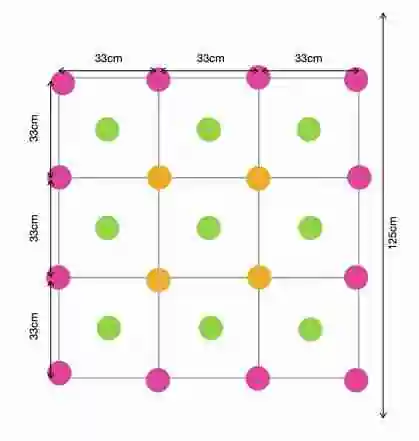
The yellow dots add extra plants, using approximately 30cm spacing between each plant using the rows. However, there is not 30cm in all directions. This could still provide sufficient spacing for flowers in a cutting garden. The pink dots use the same spacing but will depend on your bed size. If your bed is precisely 1m x 1m, the plants cannot be planted in the pink positions. But if the bed was 1.25m x 1.25m, then for a little extra space, you can add in a further 12 plants!
For simplification of calculations, I have ignored the pink planting positions. When doing this, you can squeeze in the following number of plants for the defined spacings.
| Spacing (cm) | No. of plants |
|---|---|
| 50 | 5 |
| 30 | 13 |
| 25 | 25 |
How much space is required to grow your own wedding flowers
Once you figure out the number of stems you require, as calculated from the previous steps, we can then examine the typical flower yield (the number of stems per plant at any one time) from a single plant.
The yield and the number of stems required can then be used to calculate how many plants are needed. Then using the number of plants per meter, based on their spacing, you can determine how much space you need.
Depending on the plant variety, the yield could vary from producing only one single flower per plant to producing multiple flowers at once. In the table below, I have detailed the average yield for different varieties.
| Plant | Yield | Stems Required | No. of plants | Spacing (cm) | Plants per m | Area required (m2) |
|---|---|---|---|---|---|---|
| Ammi majus | 6 | 74 | 13 | 30 | 13 | 1 |
| Snapdragon | 2 | 80 | 40 | 30 | 13 | 4 |
| China Aster | 3 | 88 | 30 | 30 | 13 | 3 |
| Cerinthe Major | 1 | 67 | 67 | 20 | 25 | 3 |
| Cosmos | 5 | 77 | 16 | 20 | 25 | 1 |
| Dill | 6 | 69 | 12 | 25 | 25 | 1 |
| Sunflower | 1 | 50 | 50 | 20 | 25 | 2 |
| Physacorpus | 17 | 1 | ||||
| Scabious | 1 | 83 | 83 | 20 | 25 | 4 |
| Totals | 605 | 312 | 19 |
As a result, the above recipe requires approximately 19m2 of growing area. This figure is approximate because the spacing can be adjusted based on the size of your flower beds. Although you should also bear in mind that the yield may be less than expected, you should scale up just in case.
How to create more growing space
If you don’t have enough space to grow all the flowers you need for your wedding, there are a few things you can do:
- Recruit help from friends and family: Ask your friends and family if you can use some flowers from their gardens or use some of their gardens to grow them. The more you share the load, the less daunting the numbers will be. If you have 10 friends willing to help, they each only need a bed about 2m x 1m to grow the flowers.
- Rent space: Consider renting a community garden plot, allotment, or a small piece of land from a local farmer to grow your flowers.
- Buy from a local grower: If you can’t grow all the flowers you need, consider buying from a local grower. This will support local businesses and ensure that you have fresh, locally grown flowers for your wedding. Many flower farmers will sell buckets of flowers for you to arrange yourself. You can find local suppliers from flowers from the farm.
- Supplement with artificial flowers: You can use artificial flowers to supplement your fresh flowers. This will help you reduce the space you need to grow your flowers and ensure enough for your wedding.
- Prioritise your flower arrangements: Consider prioritising the flower arrangements that are most important to you and reducing the number of flowers in less important arrangements.
- Choose flowers that require less space or have a higher yield: Finally, consider choosing flowers that require less space to grow or produce more flowers per plant. This will help you reduce the amount of space you need to grow all of your flowers.
Growing your wedding flowers can be a great way to save money, personalise your wedding decor, and make a sustainable choice. However, it’s essential to consider how much space you need to grow your flowers and what factors you should consider before planting.
With some planning and creativity, you can grow your own wedding flowers to create beautiful DIY wedding decor.

